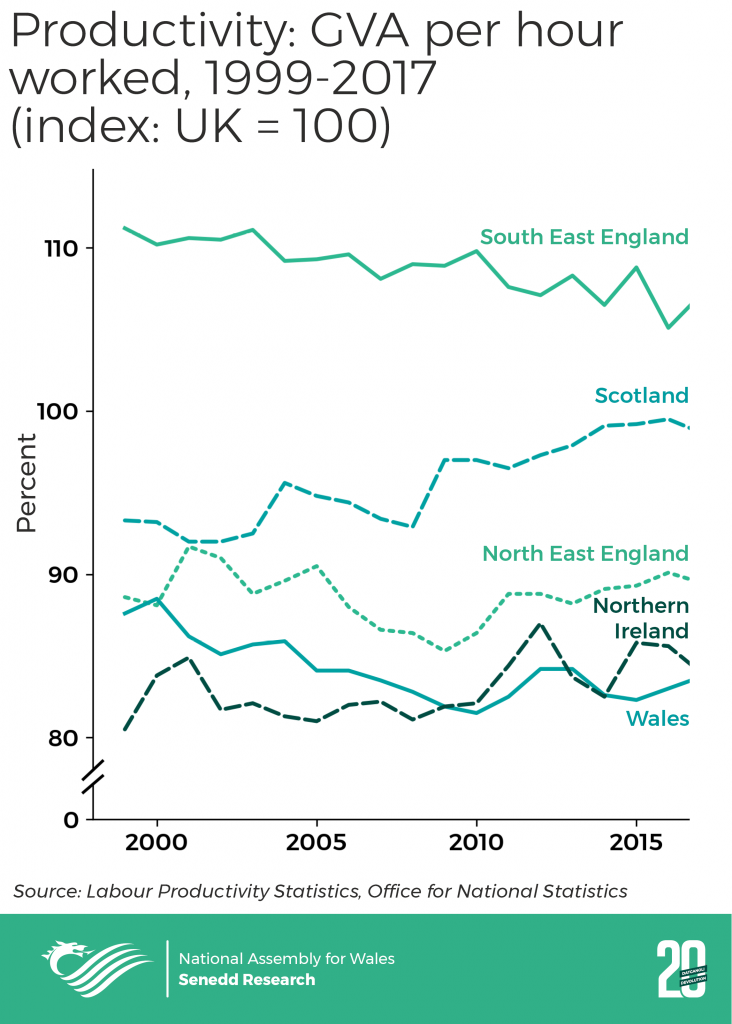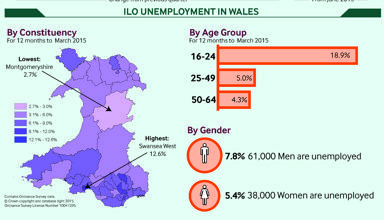Much has changed in Wales in the twenty years since the first National Assembly for Wales was elected in May 1999. This is the sixth in a series of articles that attempts to describe some of that change. It has been prepared by Senedd Research as part of the Assembly’s activity to mark twenty years of devolution
Wales has seen a mixed economic performance over last twenty years. There have been improvements in the employment rate, especially for women. However the positive effects of these improvements on the output of the economy in Wales have largely been cancelled out by a relative decline in productivity.
As such, on the basis of GVA, the main headline indicator, Wales’ position in the UK’s economic league table has remained virtually unchanged since 1999. This has led the Welsh Government to propose a new approach to economic development, focusing on the “foundational economy”. Success in this approach may not be visible in traditional high-level indicators – such as GVA – but require a more nuanced approach to measurement.
GVA per head
Gross Value Added (GVA) is a measure of the total value of goods and services produced in an area. It also shows the total value of income generated in an area (but not all of this income will necessarily be received by people living in Wales).
While acknowledged as being somewhat of a blunt instrument, GVA statistics are used to provide an overview of economic performance at regional and sub-regional level, allowing comparison between the countries and regions of the UK. Also, GVA per head estimates have, over the last 20 years, been used to guide the aspirations or track the broad outcomes of successive governments.
In every year since 2000 GVA per head in Wales has been the lowest out of the 12 UK countries and English regions. While GVA per head in Wales has increased recently (by 26.6 per cent between 2009 and 2017, the third largest increase of the 12 UK countries and English regions), this hasn’t been sufficient to change Wales’ position in the rankings.
Employment
The gap in employment rates between Wales and the UK as a whole has seen a marked improvement since 1999. The improvement in the employment rate has been especially significant for women in Wales, with rates of employment rising from 60.8% in 1999 to 69.6% in 2018. Over the same period the employment rate for women in the UK rose from 64.9% in 1999 to 70.5% in 2018.
The employment rate has also improved in West Wales and the Valleys, an area which since 2000 has benefitted from the highest level of financial support available via three successive rounds of European Union Structural Funds. According to the Welsh Government, in the last decade EU-funded projects have created 47,000 new jobs and 13,000 new businesses across Wales, while also helping more than 85,000 people into employment.
While the improvement in the employment rate is a positive step, challenges still remain related to the labour market in Wales. For instance, there are currently 43,000 people on zero hours contracts in Wales, which represents 5 per cent of the total number of people in the UK on this type of contract. In-work poverty is also a persistent issue, with 270,000 working-age adults currently estimated to be in relative income poverty despite living in households where at least one adult is in work – this is an increase of 35 per cent in the last 8 years.
Productivity
Productivity is an important economic indicator to consider as it quantifies how effectively an economy uses its resources (labour and capital). GVA per hour worked is used as a measure of productivity. On this basis Wales currently ranks at the bottom of the 12 UK countries and English regions, with a GVA per hour worked figure around 16 per cent lower than the UK average.
GVA per hour worked for 2017 in East Wales was 89.2% of the UK figure and in West Wales and the Valleys was 79.5% of the UK average.
Powys had the lowest GVA per hour worked of the 174 NUTS3 areas (the smallest geographical area for which these statistics are produced) in the UK in 2017 (65.2% of the UK figure) and Gwynedd had the fifth lowest (71.9% of the UK figure). Flintshire and Wrexham was the highest ranked Welsh NUTS3 area (at 96.4% of the UK average – putting it in 62nd place out of the 174 NUTS3 areas in the UK).
While productivity in Wales has seen some improvement relative to the UK since 2010, between 1999 and 2017 GVA per head in Wales fell from 87.6 percent to 83.7 per cent of the UK average. In comparison, regions and countries such as the North East, Scotland and Northern Ireland have been able to secure some improvement in productivity relative to the UK since 1999.
Household income
Gross Domestic Household Income (GDHI) is an estimate of the amount of money that households have available for spending or saving (when shown as ‘per head’ these are estimates of values for each person, not each household). According to the Welsh Government’s Chief Economist household income represents the single best measure of economic wellbeing.
The latest figures show that in Wales in 2016 the average person had £15,835 to spend or save (81.5 per cent of the UK average of £19,432). The 2016 figure (the latest available) for Wales was the third lowest among the 12 UK countries and English regions, slightly ahead of Northern Ireland and the North East.
Since 1999 Wales has seen the third lowest percentage increase in GDHI per head out of the 12 UK countries and English regions, up 58.8 per cent compared to a 67.4 per cent increase across the UK. This lower growth rate translates to a worsening of the figure relative to the UK average since devolution, as shown in the GDHI chart below.
Similarly, the chart shows that GDHI per head in both ‘East Wales’ and ‘West Wales and the Valleys’ has declined relative to the UK average since 1999. Central Valleys is the only NUTS3 area in Wales to have seen an improvement in GDHI per head relative to the UK average over this period, rising from 72.8 per cent to 74.7 per cent.
Time to focus on the foundations?
Successive Welsh Government economic development policies have focussed on supporting an evolving line-up of key sectors, identified based on a mix of current economic significance and/or perceived growth potential.
The economic development strategy A Winning Wales, published in 2001, referred to supporting key growth sectors. In November 2005, Wales: A Vibrant Economy included a list of ten key sectors which were ‘recognised to be important for future economic growth’. In 2008 the list grew to 14 key sectors, before the 2010 Economic Renewal Programme announced the Welsh Government’s new focus on a slimmed-down list of six key economic sectors (Creative industries; Information, Communication and Technology; Energy and Environment; Advanced materials and manufacturing; Life Sciences; and Financial and Professional services). This was then subsequently increased to nine sectors, with the addition of Food and Farming; Construction; and Tourism.
The Welsh Government’s Economic Action Plan, published in December 2017, similarly set out the Welsh Government’s intention to support four ‘foundation sectors’ – tourism, food, retail and care. (Prior to this, the Assembly’s Economy, Infrastructure and Skills Committee had produced a report on what the Welsh Government’s new plan might include – the foundational economy was one of the areas considered by the Committee). However, more recently, the First Minister’s manifesto shifted the emphasis towards a broader approach of ‘foundational economic development’.
Deputy Minister for Economy and Transport, Lee Waters AM, recently highlighted the shift in Welsh Government thinking on economic development:
“We do have a will to shift this [Welsh economic performance], but 20 years of trying shows us it is not easy. We have thrown the proverbial kitchen sink at the Welsh economy and it hasn’t budged.”
“So while making sure we nurture the companies we have got, we also need to cast out in a different direction, to try something different, as our current approach has not produced the results we hoped it would.”
The foundational economy is built from the activities which provide the essential goods and services for everyday life, regardless of the social status of consumers. These include, for example, health, education and welfare services; infrastructure; utilities; food processing; and retailing and distribution.
The foundational economy is seen as important as, unlike sectors such as manufacturing, for example, where production is concentrated in specific areas, the foundational economy is nationally distributed along with population. It is made up of the industries and firms that are there because people are there. Therefore it is seen as being vital for many people in Wales, not only in providing the goods and services they need but also employment (estimates suggest that, grounded SMEs and large scale foundational employers account for at least 40 per cent of the Welsh workforce).
The finer detail is yet to emerge as to the Welsh Government’s intended approach in this area and the Deputy Minister has made it clear that the Welsh Government will not be walking away from its ‘commitment to attracting large firms to Wales’.
However, it would appear that in seeking to support the foundational economy the Welsh Government will be hoping to improve quality of jobs; encourage the growth and retention of local, grounded businesses; and to improve the economic resilience of local communities. These are not things readily shown by conventional economic indicators. GVA, for example, as an absolute measure of economic activity tells us nothing about how this value is distributed, or what impact it has on the environment.
Other measures of economic performance exist, but so far have not been widely adopted by governments. For instance, the Index of Sustainable Economic Welfare seeks to capture environmental, social and economic factors in one measure by balancing economic output with things such as income distribution and pollution produced by production. As noted by others, a new approach to economic development will need to be accompanied by a new set of indicators if we are to understand the impact on the economy in Wales.
The next article to be published later today will look at the history of the Assembly.
Article by Ben Stokes, Senedd Research, National Assembly for Wales










